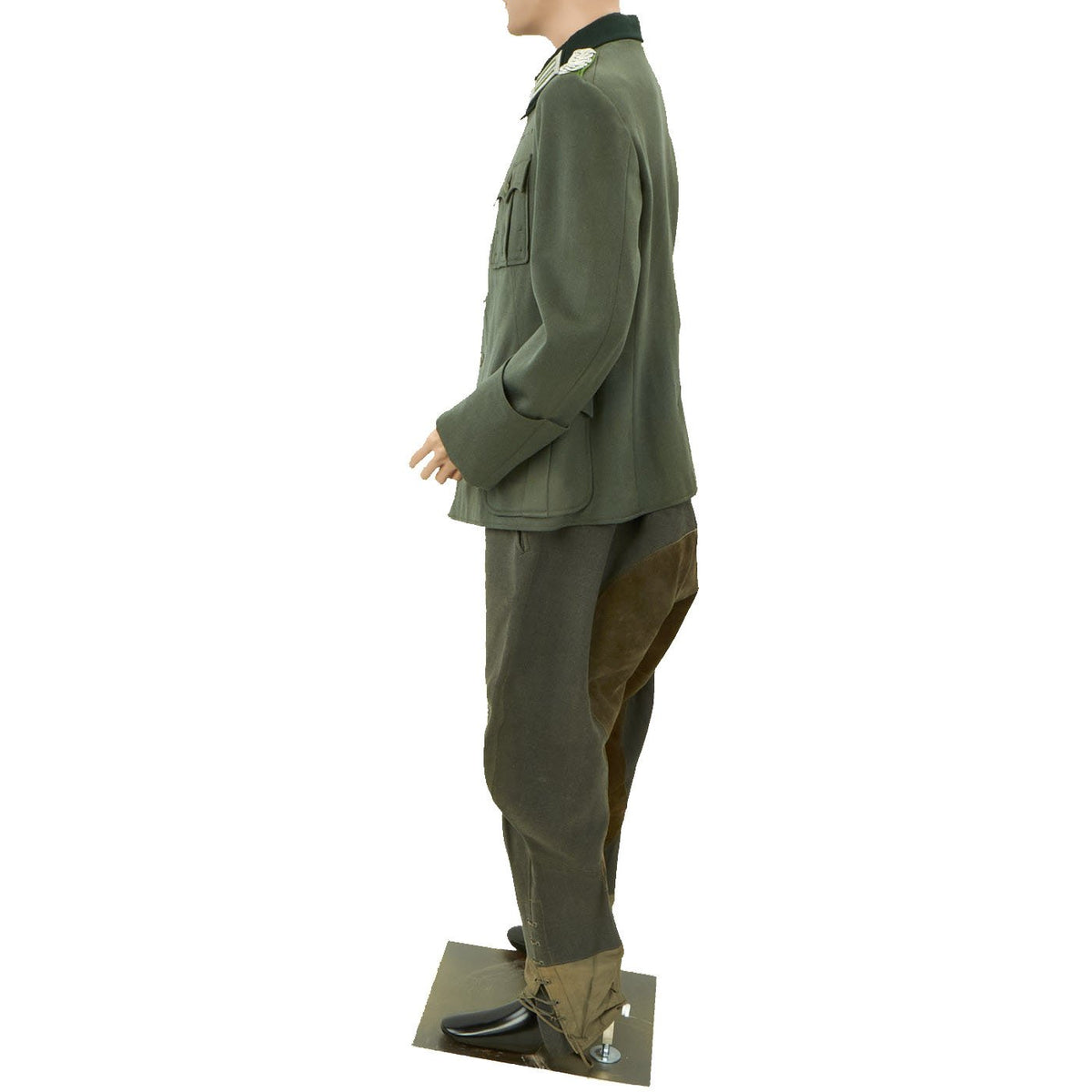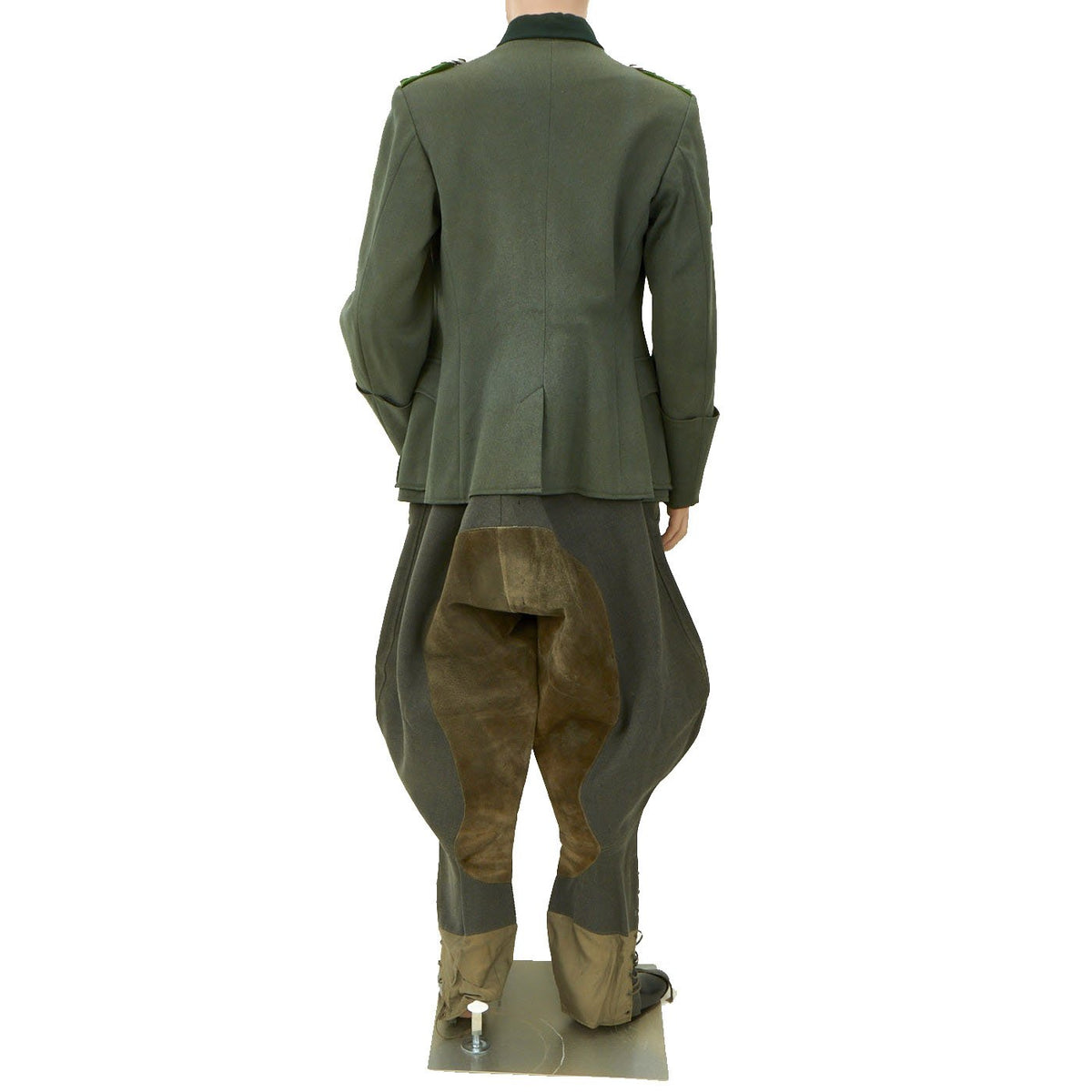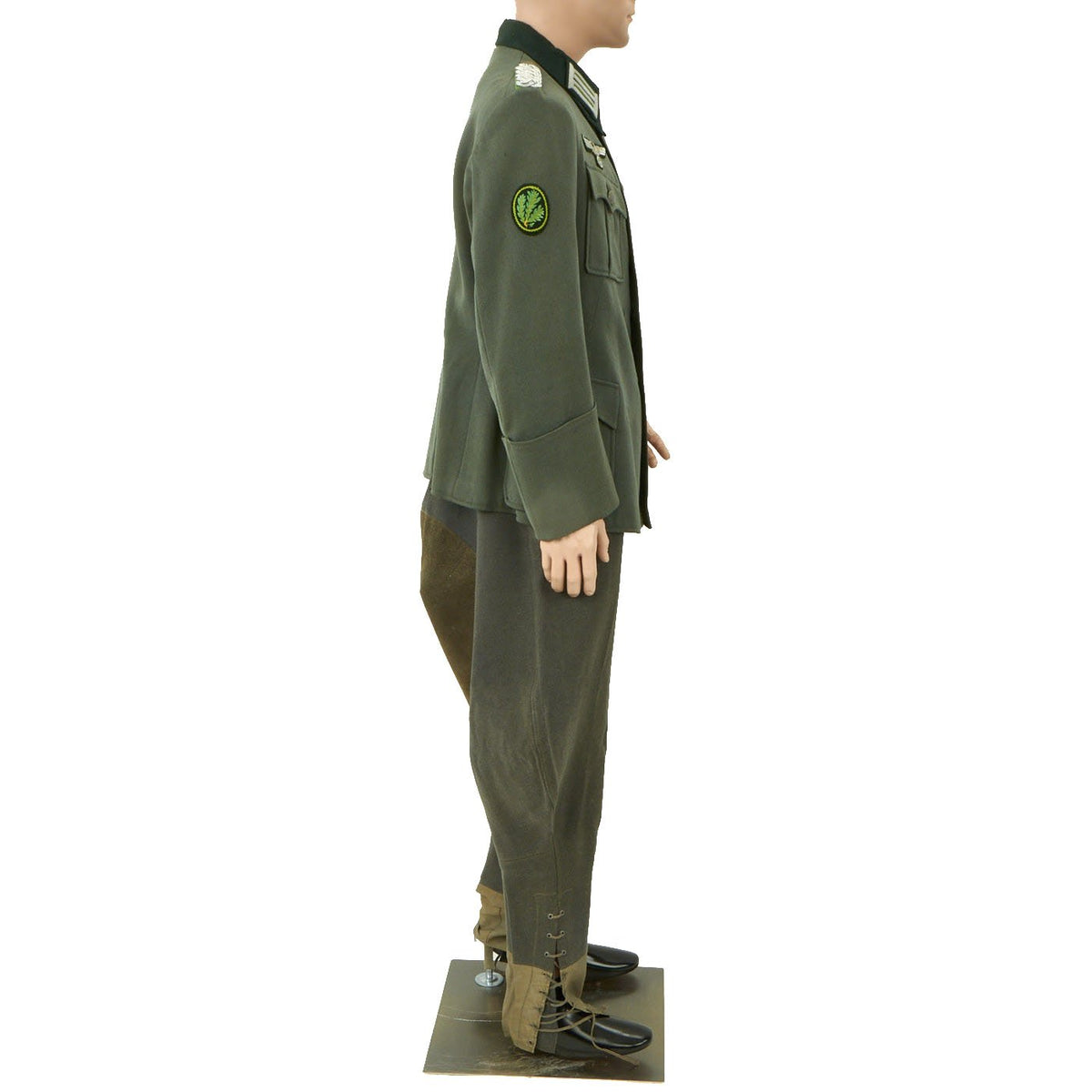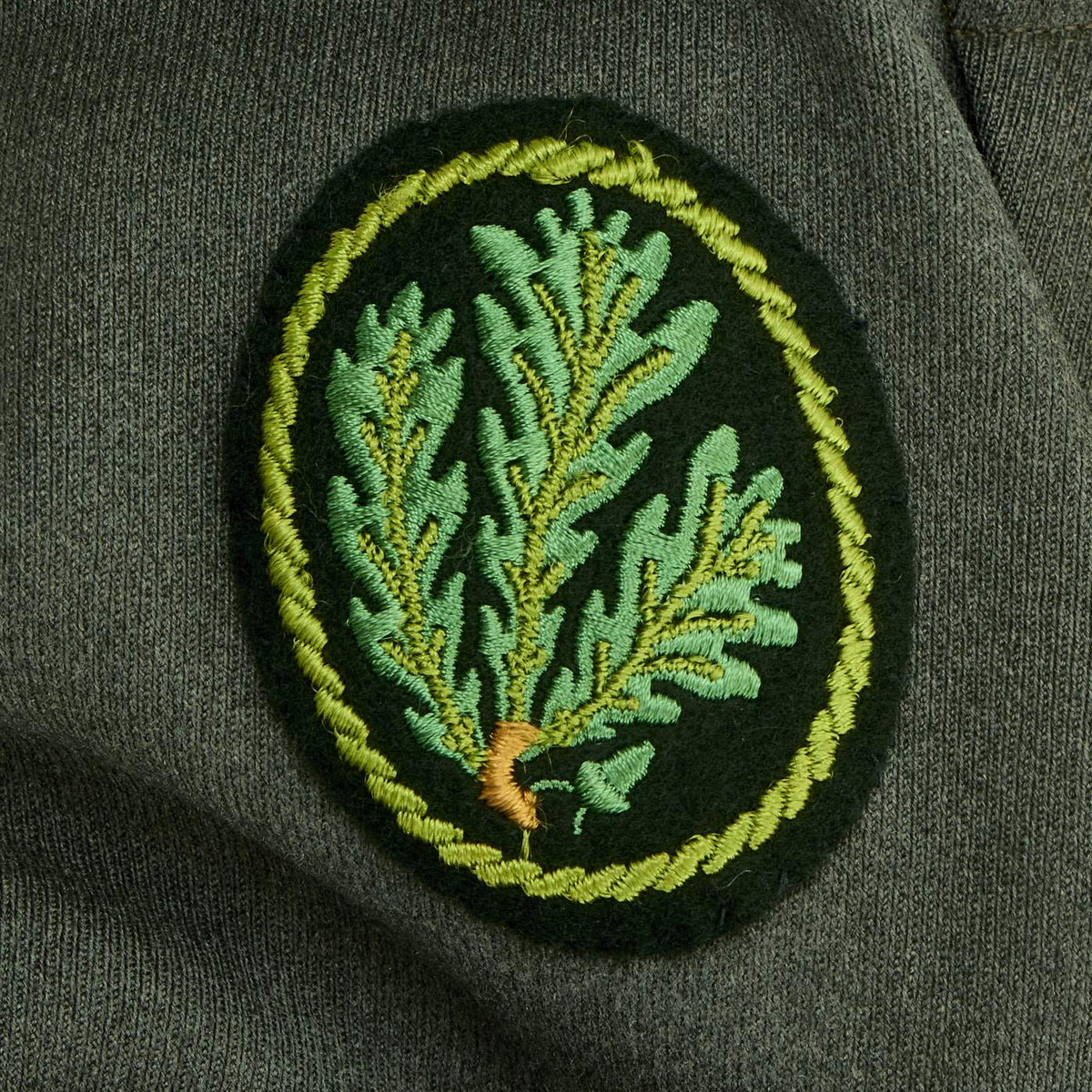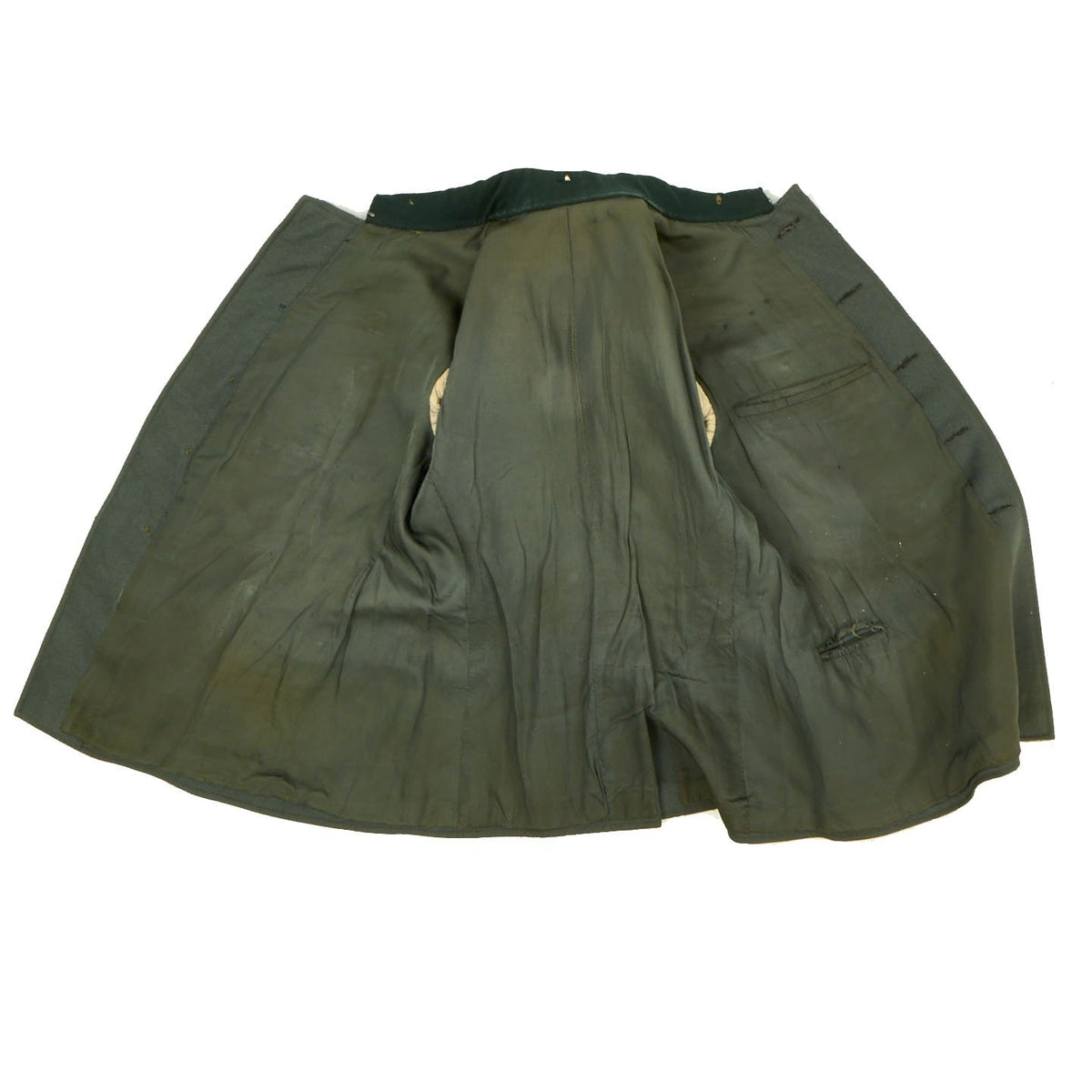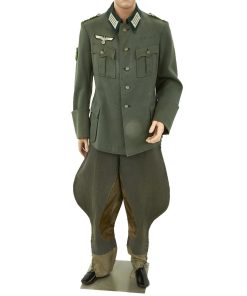Original German WWII Jager Officer M40 Feldbluse with Breeches Original Items
$ 1.995,00 $ 498,75
Original Item: Only One Available. A German Army (Heer) M40 officer Tunic for a Jäger (light infantry) regimnet. The Model 1940 Tunic was a simplification of the earlier M-1936 Tunic. The Main difference is that the “Bottle Green” Collar of the M-36 was eliminated. Future uniforms retained the pleated pockets, internal suspenders, and all other features of the earlier M-36. The Model 1940 Tunic was used throughout WWII from the Invasion of France, all the way through to the capitulation of the Third Reich in 1945.
The base of the tunic is constructed of a feldgrau wool. Four pleated pockets adorn the front, with each pocket flap being the scalloped cut and fastened with painted pebbled aluminum dish buttons. Bullion embroidered officer collar litzen with light green Jager piping are machine sewn in place, and are original to the tunic.
The Field-grade officer Russia braid shoulder boards are piped in light green, denoting Jager. The embroidered Heer breast eagle is in good condition, and is of the earlier M-36 style (Eagle on Bottle Green Field). Very nice Jager patch worn on the upper right sleeve. The pocket and main closure pebbled dish buttons are green painted aluminum, and are in good condition with a few scattered marks from use.
The interior of the tunic is lined cotton which is in overall good used condition showing only a few areas of sweat staining. This is a very nice representative of the classic German Heer M40 NCO Tunic which shows signs of true combat use.
Approximate Measurements:
Collar to shoulder: 6.5”
Shoulder to sleeve cuff: 25”
Shoulder to shoulder: 18”
Across front Chest width: 24”
Across front Waist width: 21.5”
Also included are trousers or riding breeches with classic silhouette and suede reinforcement in the crotch.
The Jager patch was worn on the upper right sleeve by Jager (light infantry) Regiments, Panzer-Grenadier Division, known as the Brandenburg Division. For most of the war, this was an elite commando unit specializing in saboteur campaigns. In July 1944, several Division members were implicated in the failed assassination plot on Hilter. It was redesignated as a conventional unit and sent into action on the Eastern Front in December 1944, where the German Army was collapsing under the Soviet advance.
After the First World War, the Jäger units of the Imperial German Army were disbanded, but their traditions were carried by infantry regiments of the 100,000-man Reichswehr of the Weimar Republic. After the Nsdap came to power in 1933 and the rearmament of Germany began, the new Wehrmacht revived the name Jäger for various types of units:
In 1935, the first specialized mountain infantry units were formed; their regiments and battalions were designated Gebirgsjäger (“mountain infantry” – Gebirge is German for “mountain range”). More specialized units, such as the Hochgebirgs-Jäger-Bataillone, for use in high-Alpine conditions, were also developed. The Waffen SS raised a “Karstjäger” Division.
When the Luftwaffe began forming parachute units in the late-1930s, the first parachute regiment was designated Fallschirm-Jäger-Regiment 1. German paratroopers became known as Fallschirmjäger (Fallschirm is German for “parachute”). At first, Fallschirmjäger was applied only to genuine airborne-qualified troops, but the term was retained for Fallschirmjäger regiments and divisions even after they began operating as regular infantry. A number of Luftwaffe Feld-Divisionen (“field divisions”), regular ground combat units raised by the Luftwaffe, also used the term Luftwaffen-Jäger-Regiment for their infantry regiments. Many of these were later taken over by the army but retained the name Jäger-Regiment.
Two Skijäger regiments were formed in 1943 as part of Skijäger-Brigade (later a Skijäger-Division).
Certain infantry divisions were raised as “light infantry divisions” (leichte Infanterie-Divisionen) in late 1940. They were raised to operate in rough terrain, especially in southeastern Europe. Their infantry regiments were called Jäger-Regimenter, and in 1942 the light and light infantry divisions were renamed Jäger divisions.
The antitank units of German divisions, originally called Panzer-Abwehr-Abteilungen (“anti-tank battalions”), began in 1940 to be redesignated as Panzerjäger-Abteilungen, (literally “tank hunter battalions”). These were equipped with towed or self-propelled guns (often the ad hoc mounting of an antitank gun on a captured or obsolete tank chassis). As the war progressed, some Panzerjäger-Abteilungen were fully equipped with specialized tank destroyers, initially known as Panzerjäger (tank hunters), and later by 1943 as Jagdpanzer (“hunting tank”) with enclosed, armored casemate superstructures.
The military police of the Wehrmacht was known as the Feldgendarmerie. In December 1943, a new force of military police, directly subordinated to the Armed Forces High Command, was formed. Its units were designated Feldjäger-Kommandos with subordinated Feldjäger battalions and regiments. These were known collectively as the Feldjägerkorps. The name was taken from the Reitendes Feldjägerkorps, a Prussian Army military police-type unit directly under the General Staff.
Fast Shipping with Professional Packaging
Thanks to our longstanding association with UPS FedEx DHL, and other major international carriers, we are able to provide a range of shipping options. Our warehouse staff is expertly trained and will wrap your products according to our exact and precise specifications. Prior to shipping, your goods will be thoroughly examined and securely secured. We ship to thousands clients each day across multiple countries. This shows how we're dedicated to be the largest retailer on the internet. Warehouses and distribution centres can be located throughout Europe as well as the USA.
Note: Orders with more than one item will be assigned a processing date depending on the item.
Before shipping before shipping, we'll conduct a thorough inspection of the items you have ordered. Today, the majority of orders will be delivered within 48 hours. The delivery time will be between 3-7 days.
Returns
The stock is dynamic and we cannot completely manage it because multiple stakeholders are involved, including our factory and warehouse. So the actual stock may alter at any time. It's possible that you may not receive your order once the order has been made.
Our policy is valid for a period of 30 days. If you don't receive the product within 30 days, we are not able to issue a refund or an exchange.
You can only return an item if it is unused and in the same state as the day you received it. You must have the item in its original packaging.
Related products
Uncategorized
Uncategorized
Uncategorized
Uncategorized
Uncategorized
Uncategorized
Uncategorized
Uncategorized
Uncategorized
Uncategorized
Armored Burgonet Helmet & Polearm from Scottish Castle Leith Hall Circa 1700 Original Items
Uncategorized
Armoured Fighting Vehicles of the World: AFVs of World War One (Hardcover Book) New Made Items
Uncategorized
Uncategorized
Uncategorized
Angolan Rebel 1970s era 60mm Inert Display Mortar from Angolan Civil War Original Items
Uncategorized
Uncategorized
Uncategorized
Uncategorized
Australian WWII Owen MK1 Machine Carbine SMG Custom Fabricated Replica with Sling Original Items
Uncategorized

